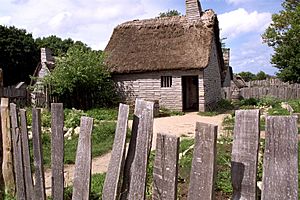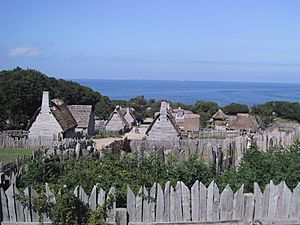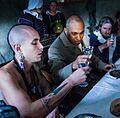Plimoth Patuxet facts for kids
Plimoth Patuxet is a special place in Plymouth, Massachusetts. It's a living history museum that helps you experience what life was like in the 1600s. The museum was started in 1947 and used to be called Plimoth Plantation.
It shows what the first English settlement, Plymouth Colony, looked like. This colony was built by people known as Pilgrims. They were some of the first Europeans to move to America. They came seeking freedom to practice their religion, separate from the Church of England.
Plimoth Patuxet is a non-profit museum. It gets help from many people, including volunteers and donations. The museum makes sure its recreations are very accurate. They use old records, paintings, and artifacts to show how people really lived. They also do a lot of research and archaeological digs.
In the English Village, you'll meet "first-person interpreters." These are people who dress, talk, and act like colonists from the 1600s. They stay in character and can tell you about their "lives" and daily tasks. You might see them cooking, planting, or caring for animals. If you have a question they can't answer in character, "third-person interpreters" (who wear modern clothes) are there to help.
Most of the year, the English Village shows life in 1627. This helps visitors understand daily routines and seasonal activities. In November, the village changes to show the year 1621. This was the year of the first Thanksgiving in Plymouth Colony.
The Museum's Story
The museum was started by Henry Hornblower II in 1947. He had help from friends and family. It began with just two English cottages and a fort by the water in Plymouth.
Over the years, the museum grew a lot. Here are some of the important additions:
- 1957: The Mayflower II, a replica of the original Mayflower ship.
- 1959: The English Village, where you can see how the Pilgrims lived.
- 1973: The Wampanoag Homesite, showing how Native Americans lived.
- 1987: The Hornblower Visitor Center.
- 1992: The Craft Center, where many items for the village are made.
- 1994: The Maxwell and Nye Barns, home to historical farm animals.
- 2013: The Plimoth Grist Mill.
At the Wampanoag Homesite, Native Americans from different tribes share their ancestors' way of life. They explain and show how the Wampanoag people lived long ago.
The museum grounds also have other cool places. The Nye Barn keeps special old breeds of farm animals. The Craft Center creates many items used in the village exhibits. There's a cinema that shows educational videos. A Colonial Education site hosts groups for learning. The visitors' center has indoor exhibits and learning programs too.
The Mayflower II ship is docked near Plymouth Rock. It is also part of the museum. On the ship, museum staff in modern clothes tell visitors about its history.
Why the Name Changed
In July 2020, the museum announced a new name: Plimoth Patuxet. This change had been planned for a while. It happened around the 400th anniversary (1620–2020) of the Pilgrims arriving in historic Patuxet.
The word "plantation" used to mean a type of colony. This was the original meaning for Plimoth Plantation. However, over time, the word became linked to large farms that used enslaved people. This was especially true in the South.
Museum leaders wanted a name that better showed the full history of the area. They wanted a name that was more welcoming to everyone. Discussions about changing the name had been going on for over a year. The new name, Plimoth Patuxet, reflects this goal.
Images for kids
-
Wigwam and Wampanoag guide
-
Recreated fort; the original fort also served as First Parish Church in Plymouth and a colony meeting house on Burial Hill.
-
Fort (which actually stood on Burial Hill) as it might have appeared when coming up Leyden Street
-
Massachusetts Governor Deval Patrick (center) during a 2011 visit






















